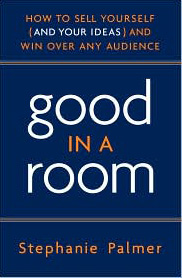Sometimes it’s harder to blog once a week than everyday. So, I’m going to start blogging as much as possible to get out of the funk I’ve been in. Should make things a bit more organic and not so planned.
Just read a Tom Peters “Cool Friends” interview from a few weeks ago with Stephanie Palmer, author of Good in a Room: How to Sell Yourself (and Your Ideas) and Win Over Any Audience.


Here are a few of my favorite nuggets from the interview:
tompeters.com asks …
Stephanie, what’s the big idea here?
SP: “Good in a room” describes anyone who presents themselves and their ideas effectively. The phrase originated in Hollywood and it’s used by agents and producers to describe people who pitch ideas well. I teach people to use, in their own industry, the tactics that work in Hollywood.
……….
Tom Peters has espoused the elevator pitch as one of the supporting columns of Wow Projects. The goal of the elevator pitch being, if you get into an elevator on the first floor with your boss and you’re trying to sell an idea, you want to sell it by the time you get to the 35th floor. You say the elevator pitch is a myth. Why is that?
SP: I think the term “elevator pitch” incorrectly implies that it’s appropriate to pitch in an elevator. Communicating quickly and concisely is important, but you should never pitch when you don’t have time to continue the conversation. A moment’s access with someone who doesn’t know you is not an opportunity. Your first interaction with someone sets the stage for the relationship to come. You shouldn’t start pitching your idea to someone before they know who you are enough to care about what you’re saying in the first place.
High-level buyers are pitched all the time. They know when they are hearing something that’s been repeated to dozens of other people. If you haven’t taken the time to build rapport and customize your pitch to that person’s specific needs, it’s a sign that you’re an amateur. Every buyer is unique, and your pitch should reflect that.
……….
You also say that networking is a waste of time. Why?
SP: I think most people who think they’re successful as a result of using traditional networking techniques succeed in spite of those techniques, not because of them. Traditional networking is generally a quantity-based approach. The idea is that if you meet enough people, accumulate enough names, you will eventually find people who are a good fit. On the surface this makes sense; you’d need a large pipeline of people because statistically only a few of them would be a right fit for your business. It’s a bulk mail strategy, sending out a lot of letters and seeing what comes back. But bulk mail is expandable, whereas we are not. The bulk mail approach doesn’t work so well in establishing genuine relationships because we only have so much time.
Therefore, instead of spending small amounts of time with lots of people, I suggest spending more time with fewer, carefully chosen people. Use a quality based approach. Upgrade from bulk mail to a handwritten letter with a first class stamp.
……….
But in as much as you don’t believe in the standard group theory of networking, you do still have a network. You categorize people a little differently than most people’s A, B, and C lists. Could you describe your system?
SP: I don’t like using the terminology of A, B, and C groups, simply because I know that I don’t want to be on anyone’s C list, and I don’t think that anyone else does, either. I start with Good People to Know, which is anybody who I think for any reason might be someone I would like to know in the future. It may be someone whom I’ve met at a conference or a barbecue. If I think that person is really interesting for whatever reason, business or personal, I’m going to include them in my Good People to Know.
If I meet someone, and I know that I have no interest in them, I’m not going to include them in my rolodex or keep tabs on them. Doing so is like being a relationship pack rat. I’m not looking to have the world’s largest network so that I can brag, “Oh, I have 10,000 people in my list.” I want to be more focused.
My next group I call the VIPs. Those are people whom I would like to have a business relationship with, but maybe I don’t know them. They’re my target list. Twenty people is the maximum that you should have on your VIP list.
My last group, and most important, is the Inner Circle. Those are the people that are closest to you, who support you professionally and personally. Those are the relationships that I spend the most time nurturing. Their support has been the most valuable for me, personally and professionally.
……….
It looks like a worthwhile book, so I’m buying a copy. Might write my own review when I finish it.
You can see more about “Good In A Room” on Stephanie Palmer’s website.
